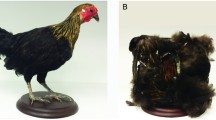Abstract
Both 14-and 55-day-old chickens were provided with a choice between novel and familiar environments under grouped test conditions. Despite manipulations of habituation periods, food deprivation, and contrast between the two test settings, no preference for novelty was observed. A mild preference for familiarity was shown by chickens habituated to the familiar side for 90 min., but this disappeared after 22 h. habituation. In all conditions a strong preference was exhibited for the environment in which the test period began. General methodological problems in measuring “exploratory” responses in this species are discussed.
Similar content being viewed by others
References
ANDERSON, E. E. 1938. The interrelationships of drives in the male albino rat III: Interrelationships among measures of emotional, sexual and exploratory behavior. Journal of Genetic Psychology, 53, 335–352.
ARCHER, J. 1973a. Influence of testosterone on chick behavior in novel environments. Behavioral Biology, 8, 93–108.
ARCHER, J. 1973b. Tests for emotionality in rats and mice: A review. Animal Behaviour, 21, 205–235.
CANDLAND, D. K., & NAGY, Z. M. 1969. The open field: Some comparative data. Annals of New York Academy of Science, 159, 831–851.
DEMBER, W. N., & FOWLER, H. 1958. Spontaneous alternation behavior. Psychological Bulletin, 55, 412–428.
DUTCH, J. 1969. Visual complexity and stimulus pacing in chicks. Quarterly Journal of Experimental Psychology, 21, 63–66.
EGGER, G. J., LIVESEY, P. J., & DAWSON, R. G. 1973. Ontogenetic aspects of central cholinergic involvement in spontaneous alternation behavior. Developmental Psy- chobiology, 6, 289–299.
FURCHTGOTT, E., & CURETON, E. 1964. Factor analysis of emotionality and conditioning in mice. Psychological Reports, 15, 787–794.
HARLESS, M. D., & COLLINS, T. B. 1971. Open field behavior in isolate and trio chicks of two age groups. Psychological Reports, 29, 787–790.
HAYES, W.N., & WARREN, J. M. 1963. Failure to find spontaneous alternation in chicks. Journal of Comparative and Physiological Psychology, 56, 575–577.
HOGAN, J. A., & ABEL, C. L. 1971. Effects of social factors on response to unfamiliar environments in Gallus Gallus Spadiceus. Animal Behaviour, 19, 687–394.
HUGHES, R. N. 1965. Food deprivation and locomotor exploration in the white rat. Animal Behaviour, 13, 30–32.
HUGHES, R.N. 1968a. Effects of food deprivation experience and sex on exploration in rats. British Journal of Psychology, 59, 47–53.
HUGHES, R. N. 1968b. A re-examination of the effects of age on novelty reactions and exploration in rats. Australian Journal of Psychology, 20, 197–201.
HUGHES, R. N. 1969. Exploration in three laboratory rodents. Perceptual and Motor Skills, 28, 90.
HUGHES, R. N. 1972. Chlordiazepoxide modified exploration in rats. Psychopharmacologia (Berlin), 24, 462–469.
HUGHES, R. N., & SWANBERG, K. M. Effects of food deprivation on exploration in deprivationally naive rats. Australian Journal of Psychology, 22, 79–84.
KIRKBY, R. J. 1967. A maturation factor in spontaneous alternation. Nature (London), 215, 784.
SAEGERT, S., & RAJECKI, D. W. 1973. Effects of prior exposure to animate objects on approach tendency in chicks. Behavioral Biology, 8, 749–754.
SALZEN, E. A. 1963. Imprinting and the immobility reaction of domestic fowl. Animal Behaviour, 11, 66–71.
SIMMEL, E. C. 1962. Social facilitation of exploratory behavior in rats. Journal of Comparative and Physiological Psychology, 55, 831–833.
SIMMEL, E. C., & WALKER, D. A. 1972. The effects of a companion on exploratory behavior in two strains of inbred laboratory mice. Behavior Genetics, 2, 249–254.
Author information
Authors and Affiliations
Additional information
These data were collected while the first author held a N.Z.U.G.C. postdoctoral Fellowship at the Ruakura Agricultural Research Centre, Hamilton, New Zealand.
Rights and permissions
About this article
Cite this article
Syme, G.J., Syme, L.A. Some Attempts to Demonstrate Exploratory Behavior in Chickens. Psychol Rec 25, 363–371 (1975). https://doi.org/10.1007/BF03394328
Published:
Issue Date:
DOI: https://doi.org/10.1007/BF03394328




